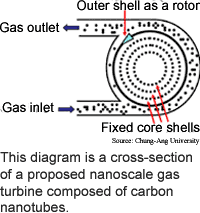
Nano gas turbine designed
One especially useful component of a microscopic
machine would be a motor. Researchers from the Chung-Ang University in
Korea have worked out how a nanoscale gas turbine made from nanotubes
would work.
Nanotubes are rolled-up sheets of carbon atoms that can be narrower
than a nanometer in diameter. A nanometer is one millionth of a millimeter,
which is the span of 10 hydrogen atoms, or one-thousandth the diameter
of an E. coli bacterium.
The researchers studied the friction between the outer nanotube
surface and gas flowing past it with the idea that this friction could
be used to provide engine torque, or the force required to turn a shaft.
They found that multiwall, or nested nanotubes, which experienced
no friction between the tubes, can be used to make nanotube motors that
can be efficiently operated and controlled by low liquid or gas flow rates.
The motor could eventually be used to drive nanoscale machines.
Previous research showed that an inner tube pulled partway out
of a multi-wall carbon nanotube will snap back due to molecular electrostatic
forces, and will continue to slide back and forth millions of times a
second.
The researchers propose to use such a nanotube oscillator as a
piston to pump the gas or liquid through a nanotube loop. The gas flow
would spin a nanotube modified to have gear teeth. The gear-modified nanotube,
embedded perpendicularly in the gas flow loop, would produce the motor's
output in the form of a rotating shaft.
In the researchers' simulations, the speed of the oscillator determined
the gas flow rate, which controlled the speed of the motor.
Nanotube motors could become practical within seven years, according
to the researchers. The work appeared in the November issue of Nanotechnology.
Video organizes paper
Conversations control computers
DNA scheme builds computers
The History Files:
A Short History of the Computer
Letter to readers
Briefs:
Copy-and-paste goes natural
RNA tiles form nanopatterns
Input device tracks muscle tremors
Nano gas turbine designed
Ultrasound makes blood stand out
Silicon surfaces speed circuits
Branchy molecules make precise pores

Research Watch blog
View from the High Ground Q&A
How It Works
RSS Feeds:
News
Ad links:
Buy an ad link
Ad links: Clear History
Buy an ad link
|
TRN
Newswire and Headline Feeds for Web sites
|
© Copyright Technology Research News, LLC 2000-2010. All rights reserved.